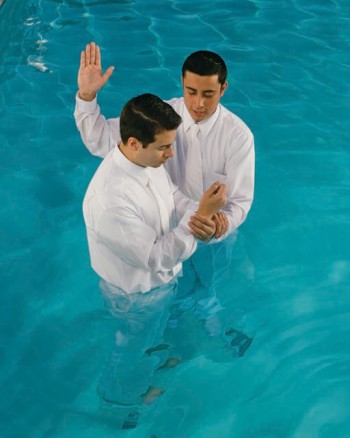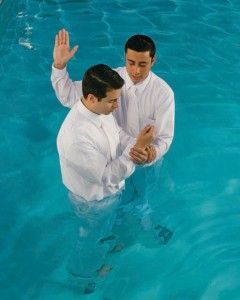In Paul’s epistle to the Ephesians, he stipulates that Christ’s true church should have “One Lord, one faith, one baptism”; the particular form of baptism he is referring to is baptism by immersion. How do we know this? Well, we can infer that Paul’s instructions held a particular regard for baptism by immersion, mainly because it is the only form of baptism the gospels tell us about and the only form Christ himself participated in and subsequently approved of. Let’s take a look at Matthew 3:16 which recounts the event, and indicates immersion specifically:
“And Jesus, when he was baptized, went up straightway out of the water: and, lo, the heavens were opened unto him, and he saw the Spirit of God descending like a dove, and lighting upon him.”(Emphasis added)
Because Christ was baptized in the Jordan River, and “went up straightaway out of the water”, we know that John was performing his baptisms by immersion. 1 Peter 2:21 instructs “For even hereunto were ye called: because Christ also suffered for us, leaving us an example, that ye should follow his steps”. This scripture, in conjunction with John 3:5, inform the sinner that in order to receive re-birth and salvation they must first be baptized, in the same manner that the Savior received the ordinance. Romans 6:3-5 further clarifies the point, giving specific instruction on how baptism is to be performed:“Know ye not, that so many of us as were baptized into Jesus Christ were baptized into his death? Therefore we are buried with him by baptism into death: that like as Christ was raised up from the dead by the glory of the Father, even so we also should walk in newness of life. For if we have been planted together in the likeness of his death, we shall be also in the likeness of his resurrection.” (Emphasis added)
We learn from the epistle to the Romans, that baptism by immersion is meant to be symbolic of the death and resurrection of Jesus Christ; being “planted” under water symbolizes being buried in the ground as if one were dead, and being lifted up out of the water symbolizes breaking the bonds of death in order to receive a resurrection, or perfect union, of body and spirit. Verse 5 above, tells us that if we are “planted together in the likeness” of Christ’s death, then we can expect to take part in the resurrection, as did the Son of God. So what happens if someone dies without being symbolically buried in the waters of baptism and in the same manner raised up to a “newness of life”? The answer to that question would be the inverse of the statement in verse 5, which declares irrevocably that the person in question will not receive the blessings of baptism. Additional evidence can be found in the account of Phillip and the eunuch (Acts 8:36-39):
“And as they went on their way, they came unto a certain water: and the eunuch said, See, here is water; what doth hinder me to be baptized? And Philip said, If thou believest with all thine heart, thou mayest. And he answered and said, I believe that Jesus Christ is the Son of God. And he commanded the chariot to stand still: and they went down both into the water, both Philip and the eunuch; and he baptized him. And when they were come up out of the water, the Spirit of the Lord caught away Philip, that the eunuch saw him no more: and he went on his way rejoicing.”
This account given in the Acts is a telling one, not only because of what it says, but more so because of what it doesn’t say. If performing baptism by sprinkling water upon the forehead of a convert was a viable method, then all Phillip would have had to do was take a handful of the “certain water” and douse the eunuch. Bearing in mind that they were traveling by chariot, as opposed to leisurely taking a stroll, they instead descend into the water- against all rational thought- where Phillip can baptize the eunuch by immersion. Obviously this particular form of baptism was important enough to be carried out by Phillip in its exactness- even in such an unusual circumstance.
Why do Mormons practice baptism by immersion exclusively? Because it is the only form of baptism documented in the gospels and more importantly the only form in which the Savior participated, approved of and admonished his apostles to perform amongst the early saints. By practicing this one form of the ordinance, the LDS church is fulfilling the guidelines laid down by the Apostle Paul, regarding the Lord’s true Church.
– Alex C.


